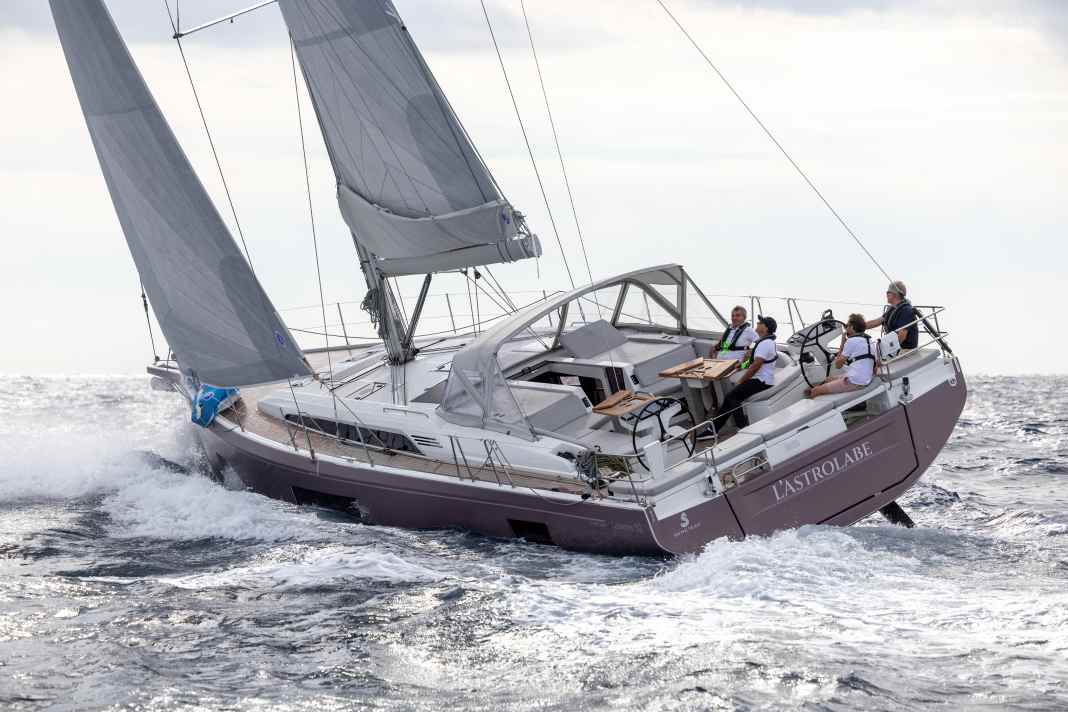





With the market launch of the Oceanis 52, Bénéteau is also saying goodbye to the previous top-of-the-range Oceanis 51.1 model after eight years in the programme. Despite external similarities, the design of the 52 is clearly different from its predecessor, whose hull was still designed by Berret-Racoupeau. The new Biscontini hull provides significantly more volume in the foredeck, a more aft-facing chine and a strongly tapered waterline at the stern. This narrowing reduces the wetted surface area and at the same time increases dimensional stability when heeling. During the YACHT test in good winds off Barcelona in Spain, the elegant Frenchwoman gave an impressive demonstration of her performance potential and also impressed with her good and lively sailing characteristics.
New shapes, new possibilities
The most striking feature of the Oceanis 52 is its completely redesigned cockpit layout. The double C-shaped seat thwarts form a flowing, diamond-shaped arrangement that enables natural movement from the companionway to the bathing platform. With two height-adjustable tables, the space can be flexibly adapted to the needs of the crew. Two spacious sunbeds can be set up and the passage through the cockpit remains free.
The two rudder blades are built relatively far under the boat. Two keel variants are available. The standard fixed keel in a sporty T-shape with ballast bomb has a draught of 2.36 metres. Alternatively, an L-shaped short keel with a reduced draught of 1.92 metres is available. The targa bracket above the cockpit is an option that was already available for the previous model. It removes the mainsheet guide from the cockpit and also enables a complete or partitioned cockpit roof with flexible bimini elements.
The new Oceanis 52 is equipped with a self-tacking jib as standard. There is also a furling mast. As an option, the boat can also be ordered with an overlapping genoa and a conventional mast with slightly more sail area. Sporty sailors also have the option of equipping their boat with a 1.85 metre higher performance rig. In this version, the Oceanis can carry up to 143 square metres of sail area on the wind (standard: 94 square metres). The sail carrying capacity increases to the extremely sporty value of 4.8.
Lots of variance, lots of comfort
The interior design provides for a layout with three, four or five double cabins. There is also a maximum of three heads compartments. On request, Beneteau will also install a cabin for the skipper in the bow instead of a large sailing cabin as on the standard boat. Beneteau's designers have paid particular attention to comfort in the owner's cabin in the foredeck. With a 1.65 metre wide island bed, a separate wet room (shower and WC in separate rooms) and plenty of storage space, it is designed to meet the highest standards of comfort.
Beneteau will be presenting the Oceanis 52 as a novelty at the boot trade fair in Düsseldorf. An initial price announcement has also already been published on the Beneteau website: the new Oceanis flagship will cost 571,690 euros, gross including 19% VAT. The detailed test report will appear in an upcoming issue of YACHT.
Technical data Oceanis 52
- Designer: Biscontini Yacht Design
- Interior styling: Nauta Design
- Hull length: 15.31 m
- Overall length with bowsprit: 15.75 m
- Length waterline: 14.67 m
- Width: 4.84 m
- Weight: 14.47 tonnes
- Standard draught (T-keel): 2,36 m
- Ballast/proportion standard keel: 3.39 t / 23 %
- Draft short keel (L-keel): 1,92 m
- Ballast/proportion short keel: 3.6 t / 25 %
- Mast height above WL: 22.00 m
- Mast height above WL (performance rig): 23.85 m
- Mainsail furling mast (standard): 46.50 m2
- Mainsail for classic mast: 59.50 m2
- Mainsail for performance rig: 66.50 m2
- Self-tacking jib (standard): 47.50 m2
- Genoa 105% optional: 59.50 m2
- Genoa 105% for performance rig: 76.50 m2
- Motorisation: Built-in diesel Yanmar 110 hp / Saildrive
- Fuel capacity: 200 litres / + 200 litres optional
- Fresh water capacity: 420 litres / + 300 litres optional
- CE design category: A(13) / B (14) / C (16)

